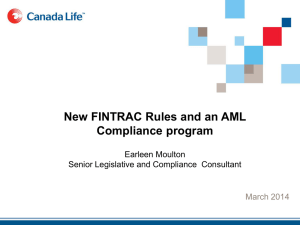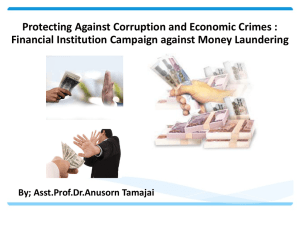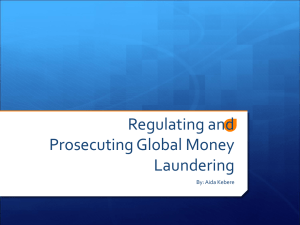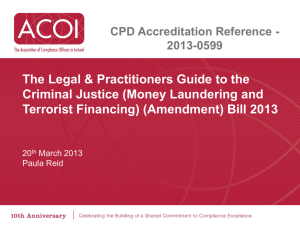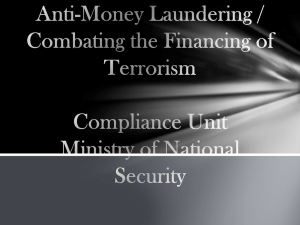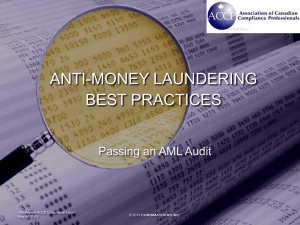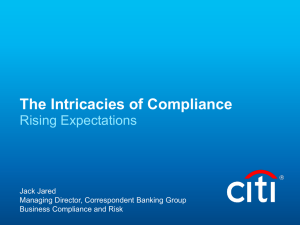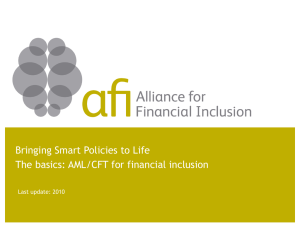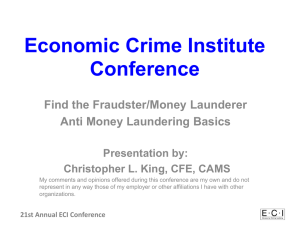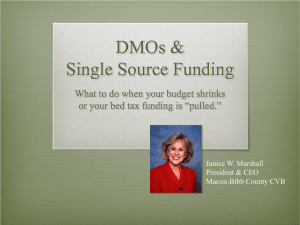Thailand`s Anti-Money Laundering Measures in Compliance with the
advertisement
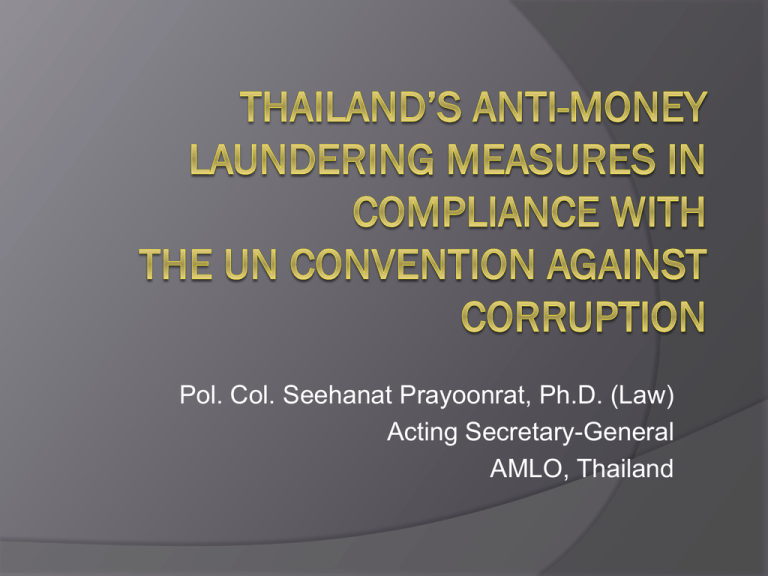
Pol. Col. Seehanat Prayoonrat, Ph.D. (Law) Acting Secretary-General AMLO, Thailand Development of AML Measures in Thailand & UNCAC Corruption issue has been rising on the global agenda and has stayed in the focus of the world society for ages. Recognized internationally as a crime that not only harms the transparency image and reputation of jurisdictions but also ruins their sustainable development economically, socially, politically and also in terms of their governance. 2 Proceeds from corruption can be laundered anywhere in the world and in the number of ways using high or new technologies or complex methods to avoid detection from competent authorities. One effective measure to combat corruption is AML measures. The AML measures create channels of sharing information and domestic and international cooperation that help to trace these illicit funds. Corruption and money laundering have a linkage. Thus, the measures to prevent money-laundering was set up in the UNCAC Articles 14, 23, 24, 31. 3 UNCAC Article 14 1. Each State Party shall: (a) Institute a comprehensive domestic regulatory and supervisory regime for banks and nonbank financial institutions, including natural or legal persons that provide formal or informal services for the transmission of money or value and, where appropriate, other bodies particularly susceptible to money-laundering, within its competence, in order to deter and detect all forms of money-laundering, which regime shall emphasize requirements for customer and, where appropriate, beneficial owner identification, record-keeping and the reporting of suspicious transactions; (b) Without prejudice to article 46 of this Convention, ensure that administrative, regulatory, law enforcement and other authorities dedicated to combating money-laundering (including, where appropriate under domestic law, judicial authorities) have the ability to cooperate and exchange information at the national and international levels within the conditions prescribed by its domestic law and, to that end, shall consider the establishment of a financial intelligence unit to serve as a national centre for the collection, analysis and dissemination of information regarding potential money-laundering. 2. States Parties shall consider implementing feasible measures to detect and monitor the movement of cash and appropriate negotiable instruments across their borders, subject to safeguards to ensure proper use of information and without impeding in any way the movement of legitimate capital. Such measures may include a requirement that individuals and businesses report the cross-border transfer of substantial quantities of cash and appropriate negotiable instruments. 4 UNCAC Article 14 (Cont.) 3. States Parties shall consider implementing appropriate and feasible measures to require financial institutions, including money remitters: (a) To include on forms for the electronic transfer of funds and related messages accurate and meaningful information on the originator; (b) To maintain such information throughout the payment chain; and (c) To apply enhanced scrutiny to transfers of funds that do not contain complete information on the originator. 4. In establishing a domestic regulatory and supervisory regime under the terms of this article, and without prejudice to any other article of this Convention, States Parties are called upon to use as a guideline the relevant initiatives of regional, interregional and multilateral organizations against money-laundering. 5. States Parties shall Endeavour to develop and promote global, regional, sub regional and bilateral cooperation among judicial, law enforcement and financial regulatory authorities in order to combat moneylaundering. 5 UNCAC Article 23 (a) (i) The conversion or transfer of property, knowing that such property is the proceeds of crime, for the purpose of concealing or disguising the illicit origin of the property or of helping any person who is involved in the commission of the predicate offence to evade the legal consequences of his or her action; (ii) The concealment or disguise of the true nature, source, location, disposition, movement or ownership of or rights with respect to property, knowing that such property is the proceeds of crime; (b) Subject to the basic concepts of its legal system: (i) The acquisition, possession or use of property, knowing, at the time of receipt, that such property is the proceeds of crime; (ii) Participation in, association with or conspiracy to commit, attempts to commit and aiding, abetting, facilitating and counseling the commission of any of the offences established in accordance with this article. ……. 6 UNCAC Article 24 Provisions about concealment of proceeds of crime and requires a State Party to establish as a criminal offence, when “committed intentionally after the commission of any of the offences established in accordance with this Convention without having participated in such offences, the concealment or continued retention of property when the person involved knows that such property is the result of any of the offences established in accordance with this Convention…” 7 UNCAC Article 31 Freezing, seizure and confiscation measures as tools of AML to disrupt corruption activity from the benefit of their illegal proceeds. 8 Other conventions related to ML The United Nations Convention against Illicit Trafficking in Narcotic Drugs and Psychotropic Substances (Vienna Convention 1988) The United Nations Convention against Transnational Organized Crime (Palermo Convention) 9 Anti-Money Laundering Office AMLO serves as Financial Intelligence Unit and law enforcement agency in Thailand. 10 The Anti-Money Laundering Act B.E. 2542 (1999) ONCB 8 March 1995 H.M. the King signed 10 April 1999 Published in Government Gazette 21 April 1999 Cabinet 2 July 1996 Prime Minister Submitted to H.M. the King 1 April 1999 Effective 19 August 1999 Council of State 23 September 1996 Parliamentary Approval 17-19 March 1999 AMLA No. 2 2 March 2008 Cabinet June 1997 Joint Commission of House of Representatives and Senate 8 August 1997 AMLA No. 3 Published in Government Gazette 22 July 2009 and effective 120 days after its publication 11 Overview of the AMLA 1999 Chapter 1: General Provisions (Section 5-12) Chapter 2: Report and Identification (Section 13-23) Chapter 3: Anti-Money Laundering Board (Section 24-31) Chapter 4: Transaction Committee (32-39) Chapter 5: Anti-Money Laundering Office (Section 40-47) Chapter 6: Assets Management (Section 48-59) Chapter 6/1:Anti-Money Laundering Fund (Section 59/1- 59/7) Chapter 7: Penalties (Section 60-68) 12 Legal Measures • AMLA provides special legal measures as follows; Criminal Measure – criminal offense of money laundering includes aiding and abetting the commission of the offense or assisting the offender before or at the time of the commission of the offense, Civil forfeiture procedures under Chapter 6 13 AMLA Section 40 to carry out acts in the implementation of resolutions of the Board and the Transaction Committee and perform other administrative tasks; to receive transaction reports submitted under Chapter II and acknowledge receipt thereof as well as receive reports and information related to transactions from other sources; to receive or send reports or information related to transactions in order to comply with this Act or other laws; to collect, compile, trace, examine, study, evaluate and analyze reports and information in connection with the making of transactions; to gather evidence for the purpose of taking legal proceedings against offenders under this Act; to conduct projects with regard to the dissemination of knowledge, the giving of education and the training in the fields involving the execution of this Act, or to provide assistance or support to both Government and private sectors in organizing such projects; and to perform any other acts under this Act or under other laws. 14 AMLA Section 3(5) The offense relating to malfeasance in office or malfeasance in judicial office under the Penal Code, offence under the law on offences of officials in State organizations or agencies or offence of malfeasance in office or corruption under other laws. Since 2009 there have been 53 corruption cases under AMLO investigation, and the total number of cases relating to corruption from 1999 is about 600 cases with the property involved worth around 250 million Baht. 15 AML as one of the Preventive Measures against Corruption FIs and DNFBPs are often used in money laundering transactions Rules and regulations for AML preventative measures are critical to protect the financial system and DNFBPs from the abuse of corrupted people. Preventative measures can be used in the prevention and suppression of corruption-related offences. 16 FATF AML/CFT preventative measures Provisions for law-enforcement and internal audit mechanisms Provisions for measures to seize/freeze and confiscate assets gained through drug Provisions for KYC/CDD procedures for FIs and DNFBPs Provisions for FIs and reporting entities to report suspicious transaction /activity to FIU 17 FATF AML/CFT preventative measures (Cont.) Provisions encouraging both domestic and international cooperation in law enforcement in all aspects Provisions for regulation of electronic transfers as well as declaration and disclosure of cross-border movement of cash 18 FATF Rec. 6 Financial institutions should be required to have in place appropriate risk management systems to identify and treat Politically Exposed Persons (PEPs). According to the FATF definition, PEPs are individuals who are or have been entrusted with prominent public functions in a foreign country, for example Heads of State or of government, senior politicians, senior government, judicial or military officials, senior executives of state owned corporations, important political party officials. Business relationships with family members or close associates of PEPs involve reputational risks similar to those with PEPs themselves. The definition is not intended to cover middle ranking or more junior individuals in the foregoing categories. Jurisdictions are also encouraged to sign, ratify, and implement the UNCAC. 19 Thailand’s Existing AML Measures Reporting Requirements for FIs and DNFBPs Customer Identification and Verification KYC/CDD Sanctions against Reporting Entities 20 Reporting Requirements for FIs & DNFBPs Cash Transactions Property Transactions 2,000,000 Baht 5,000,000 Baht Suspicious Transactions 21 Customer Identification and Verification Section 20. Financial institutions and traders under section 16 shall require all customers to identify themselves prior to making a transaction as prescribed in the Ministerial Regulation, unless such customers have previously made such identification. There shall also be a measure to eliminate obstacles in identification of the disabled or incapacitated. The identification under paragraph one shall be in accordance with the procedure prescribed by the Minister Section 20 amended in accordance with the Anti-Money Laundering Act (No.3) B.E. 2552 (2009) 22 Section 20/1. Financial institutions and traders under section 16 (1) and (9) shall establish customer acceptance policy and risk management possibly relating to customer’s money laundering and shall verify customer identification on the first transaction-making and periodically review until the account is closed or relationship with its customer terminates. The scope of verification of customer identification under paragraph one shall be in accordance with the rules and procedures as prescribed by the Ministerial Regulation pertaining to identifying and verifying customer identification, reviewing customer’s account and monitoring the movement of customer’s account that are informed by the Office Section 20/1 added in accordance with the Anti-Money Laundering Act (No.3) B.E. 2552 (2009) 23 KYC/CDD KYC/CDD requirements under AMLA’s Sections 20, 20/1, 22, 22/1 FIs and DNFBPs are required by AMLA to implement KYC/CDD procedures, such as Have in place a written policy, procedures and controls for AML/CFT Have in place an appropriate management system, at least, appoint a management officer for compliance Ensuring the sufficiency of personnel, equipment and information technology and mechanism that allow independence. Identify and verify customers or beneficial owners using reliable documents Monitor accounts and customers Issue customer acceptance and risk management policy 24 KYC/CDD (Cont.) Conduct CDD and ongoing CDD procedures Enhanced CDD for some types of customers or accounts Implement risk management procedures Should not keep anonymous or false name accounts Obtain information on purpose of relationship keep customer identification records and due diligence records for five years from the date the account was closed or relationship was terminated Regularly train FIs’ staffs in AML/CFT 25 ML Criminal Penalty Section 60 Any person who commits an offense of money laundering shall be liable to imprisonment for a term of one year to ten years or to a fine of 20,000 Baht to 200,000 Baht or both. 26 Sanctions against Reporting Entities Section 62 Any person who violates or refuses to act under Section 13, Section 14, Section 16, Section 20, Section 20/1, Section 21, Section 22, Section 22/1, Section 35 or Section 36 shall receive a fine not exceeding five hundred thousand Baht and an additional amount not exceeding five thousand Baht for each following day that the violation was not corrected or until the action was carried out correctly 27 Sanctions against Reporting Entities (Tipping-Off) Section 66. Any person who, having or probably having knowledge of an official secret in connection with the execution of this Act, acts in any manner that enables other persons have knowledge or probable knowledge of such secret shall be liable to imprisonment for a term not exceeding five years or to a fine not exceeding one hundred thousand Baht or both, except in the case of doing such act in the performance of official duties or in accordance with the law. 28 Implementation of AML Measures and Their Consequences in Relation to the Combat against Corruption Chapter 6 of the AMLA provides for the Civil measure – civil forfeiture procedures i.e. the case can be initiated from the asset without the presence of offender and not directly connected with criminal case (if any) against the offender. 29 Civil measures features 1. 2. 3. 4. For the protection of social benefit and public interest Retrospective enforcement Not directly connected with criminal case. Whether or not the offender was arrested or convicted, the civil forfeiture can be pursued Include not only asset derived from commission of crime, but also the asset that was transferred or any interest accrued from such asset 30 Civil measures features (cont.) Burden of proof shifts to the person who claims the right of asset, 6. Where a person claims the right of asset, and the person is or had been related to the offender of predicate offense or money laundering offense, it shall be presumed that all asset claimed were related to the offense or transferred in bad faith, 7. It is possible to file a petition for court order to forfeit the asset connected with the commission of offense which was found thereafter, 8. Does not have to prove beyond reasonable doubt. 5. 31 Initiation of case • There is a probable cause to believe that the person carrying out the suspicious transaction is involved with commission of predicate offense • Upon receiving reports or investigation files from authorities • Upon having a complaint or an arrest of person committing predicate offense or money laundering offense • When money or asset connected with the offense was found during the search of person or residence or vehicle 32 Asset Forfeiture Procedure under AMLA Reports from Financial Institutions Reports from Land Offices Reports from 9 professions & information from other sources Anti-Money Laundering Office Transaction Restraint Transaction Committee or Secretary-General Temporary Asset Seizure or Restraint Probable Cause 3 Days* 10 Days Public Prosecutor Notice Announcement Owner/Transferee/Beneficiary file petition Return of Asset Owner file petition AML Board Civil Court AML Board 90 Days* Forfeit Secretary General Public Prosecutor Prove of ownership or bona-fide beneficiary Civil Court Return of Asset (Urgent) 33 Thank you Q&A Pol.Col. Seehanat Prayoonrat, Ph.D. Anti-Money Laundering Office snat@amlo.go.th 34
